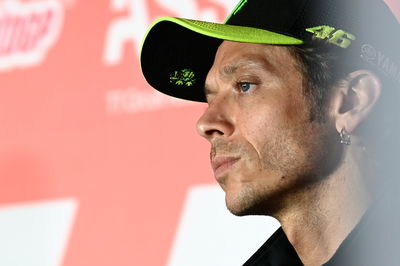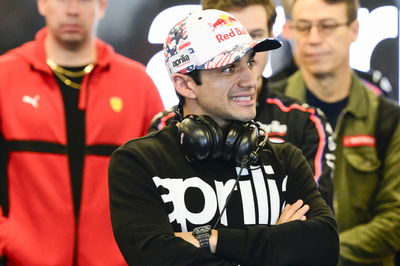Randy Mamola: ‘If you have a problem with F1, you have a problem with MotoGP’
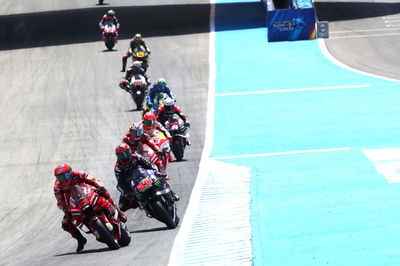
There were only two races with last-lap passes for victory in MotoGP this season, when Enea Bastianini overtook Francesco Bagnaia on the final tour of MotorLand Aragon and when Alex Rins snatched the advantage from Bagnaia at Phillip Island.
While four riders remained in mathematical title contention until the penultimate round, the quality of racing was sometimes called into question by fans, media and the riders themselves.
Marc Marquez was particularly vocal, the eight-time world champion highlighting that the sport’s latest technology is taking control away from the riders, meaning it is harder to make a difference.
This includes aerodynamics, which creates a kind of ‘dirty air’ situation more commonly associated with Formula 1; and ‘ride height devices’, which decrease the extent to which the bike ‘wants’ to wheelie on corner exit, and also provide some benefit in braking, allowing riders to brake harder initially.
“If you’re not a fan [of Formula 1] then you cannot be a fan of MotoGP either,” said 13-time Grand Prix winner Randy Mamola, “because what we used to hear from Formula 1 three, four, five years ago is ‘I can’t follow the car in front of me’, and we’ve got that [problem of riders struggling to follow] in bike racing?”
However, the solution is less simple. Formula 1 reached the point of huge wings and significant turbulence decades ago. Reducing their effect has been part of F1’s ambitions for at least the last 10 or 12 years.
Like in F1, MotoGP aerodynamics opened up a new avenue of untapped performance, where greater gains were possible compared to more familiar areas such as suspension geometry, chassis flex or engine character.
“It’s about the era,” Mamola says, “it’s about where the regulations are, and where that sits.”
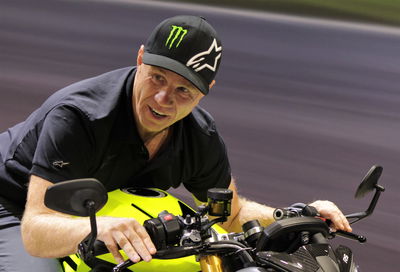
As much as it should not be a surprise that MotoGP has followed the same path as F1, the identity of the first manufacturer to really exploit aerodynamics - as well as other non-traditional technologies - should also not be a surprise.
“I believe one manufacturer at this moment has a pretty big grip on this, more than one rider can win on the bike, it’s Ducati,” Mamola said.
Ducati has Gigi Dall’Igna as the head of their Desmosedici project. Mamola describes Dall’Igna as the Adrian Newey “for two wheels,” Newey being the lead designer on a number of successful F1 cars, most recently with Red Bull, who have won all of their world titles with Newey-designed machines.
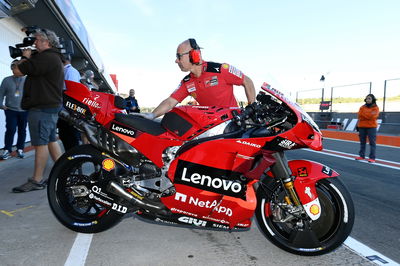
More than that, when Dall’Igna arrived in Ducati in 2014, they were in the middle of their MotoGP nadir. Having lost Casey Stoner and failed with Valentino Rossi, Ducati bet on Dall’Igna to return them to the peak of motorcycle racing, which they finally achieved this year.
Dall’Igna was the first to make the most of aerodynamics, with wings appearing on the Desmosedici GP15, the first Ducati MotoGP bike to really feel Dall’Igna’s influence. Then he brought ‘holeshot devices’ in 2019, and by the end of the year the ‘holeshot device’ had become the ‘ride height device’.
Ducati were also one of the first factories to use software to help predict, before the race weekend began, which tyre would be optimal for the race. All of this while maintaining the Desmosedici as the fastest motorcycle in MotoGP.
“So, for me, put a freeze,” Mamola said. “You’re [frozen] at doing those specific things so that other manufacturers can catch up, that Ducati can’t take it to the next level, or whoever else.
“How they do that, I don’t know, I’m not a regulation or a rule guy or something, but I think something has to happen - concessions for other manufacturers.”
While one solution could be to remove such technology and return MotoGP to the state of 2014, for example, albeit with unified electronics, MotoGP is also meant to be a prototype class where engineering innovation is theoretically encouraged.
However, the aforementioned unified electronics from 2016, the single tyre manufacturer introduced in 2009, the limits on engine capacity, all detract from the extent to which MotoGP bikes are true prototypes.
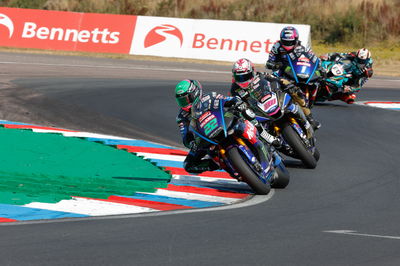
More ‘eye candy’ in BSB and WorldSBK
“Some of the best races I saw [were] with World Superbike and BSB,” said Mamola.
“One of the best ones was Thruxton BSB - I mean that is probably the highlight, those three races.
“I watched all three, and then I linked it and sent it to people going ‘this is racing.’
“So, Thruxton, awesome for the ‘eye candy’, meaning you get to see this action and they’re really controlling the bike and drifting it and so on.
“But if you really want to do a lap time, it needs to straighten up and you need to be perfect. You need to brake deep, but not over-brake because it goes sideways.”
“BSB and WorldSBK”, Mamola says, is “just a different style of racing, it’s just a different platform in which it’s on, and we have to understand those platforms better.”
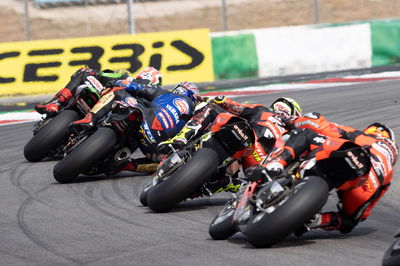
On the other hand, in MotoGP, “Unfortunately, we don’t get to see what we would like to see from the ‘eye candy’ side of things,” Mamola says.
He continues, “You’re trying to go from A-B as fast as you can, the engineer types it in, and this is what you do.
“Before you used to play with the throttle, the thing would start to wheelie, even with a certain amount of electronics, but now you can come out and in second gear just [open the throttle], and the wing will help it drive by going down.
“The bikes are incredibly fast accelerating and stopping.”
“Now we’re running into problems that Formula 1 have,” Mamola said, “so if you have a problem with Formula 1, you have a problem with [MotoGP].”
By Alex Whitworth
